Although this is off topic from aquarium fish, as a volunteer for the Marine Mammal Center, this is a current issue that needs its own article.
It’s that time of year again! Seal pups and weaners will start washing up on the beaches along the California coast. Elephant seal weaners have begun to leave their moms and those that aren’t quite ready to make it on their own will have a rough couple of weeks. Harbor seal pups are also being born this time of year.
RULE #1: IF YOU SEE A SEAL ON THE BEACH, DO NOT APPROACH IT!
RULE #2: DO NOT APPROACH A SEAL NO MATTER HOW CUTE IT LOOKS!
Harbor seal pups are left on the beach by their moms while mom goes out to find food. If you approach them or move them, mom will most likely NOT come back for them. You do them no favors by going up to them and taking away their best chance for survival. It is absolutely fine to take pictures, but do so at a safe distance (at least 50’ from the animal). Any pictures you take can be passed along to your local rescue organization and are very helpful in gathering data.
IF YOU SEE A SEAL, PLEASE CALL YOUR LOCAL MARINE MAMMAL RESCUE AS SOON AS POSSIBLE!
Humboldt and Del Norte counties – (707) 465-6265
Medicino through San Mateo counties – (415) 289-SEAL (7325)
Santa Cruz and Monterey counties – (831) 633-6298
San Luis Obispo county – (805)771-6298
Orange county – (949) 494-3050
Los Angeles county – (310) 548-5677
San Diego county – (800) 541-7325
Is your area not listed? Click here for the National Marine Fisheries Service database of rescue organizations.
Know your Pacific marine mammals:
California Sea Lions: At any age, sea lions are notably different in appearance
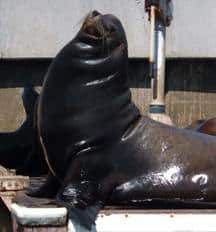
than their seal cousins. Sea Lions have external ears, little flaps or pinnae, and long front flippers that are dark in color. Their front flippers can cover up to ½ of their body length. Sea lions can also tilt their pelvis underneath their body and stand up, giving them the ability to run along the beach.
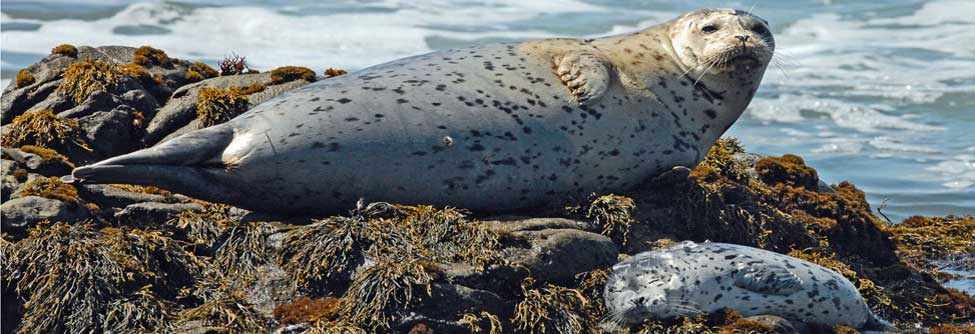
Pacific Harbor Seals: These are the cute, little seals all over the news. When they are born premature, they are covered in a yellow-white coat called, lanugo. At such a young age, it is very common to see a short umbilical stump still attached. Most people report it as a “worm” or hernia. When they get bigger they are grey and covered in spots. They have short little flippers and bounce along the beach on their bellies. They are not injured, it’s just how they get around since they don’t have the long front flippers like sea lions.
Elephant Seals: These seals have big eyes and a big, flat nose. They are usually
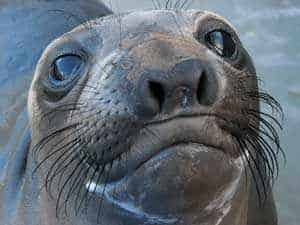
seen on the beach after their first molt, and are a silvery grey color. Before the first molt, they have a black, fuzzy coat. They will stay with their mothers as “blackcoats” for about 28 days and then mom takes off, and they have to figure out how to find food on their own. Año Nuevo State Park, just north of Santa Cruz county, is one of the established pupping areas. Guided tours of the area are given seasonally. These tours allow up close viewing of the seals with informed tour guides. They also have short little flippers and get around by the belly bounce.
Northern Fur Seals: These seals are more rare in these areas, but can be found.
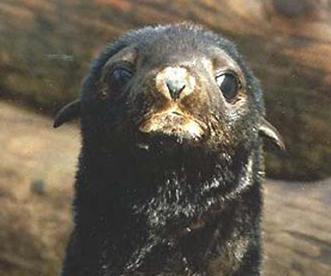
The only known rookery is on San Miguel Island. They also have external ear flaps and long front flippers. Most commonly, the pups are stranded and they are small and fuzzy.
Sea Otters: Everyone knows what a cute, fuzzy sea otter looks like. These guys are known to haul out into a nice spot and take a nap. They have even been found off the 18th hole of Pebble Beach golf course!
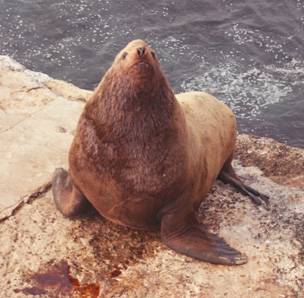
Even more rarely spotted are Stellar Sea Lions and Guadalupe Fur Seals. Stellar sea lions are common more on island beaches and along central and northern California. Guadalupe fur seals are native to Mexico, but have been seen as far north as San Francisco.
